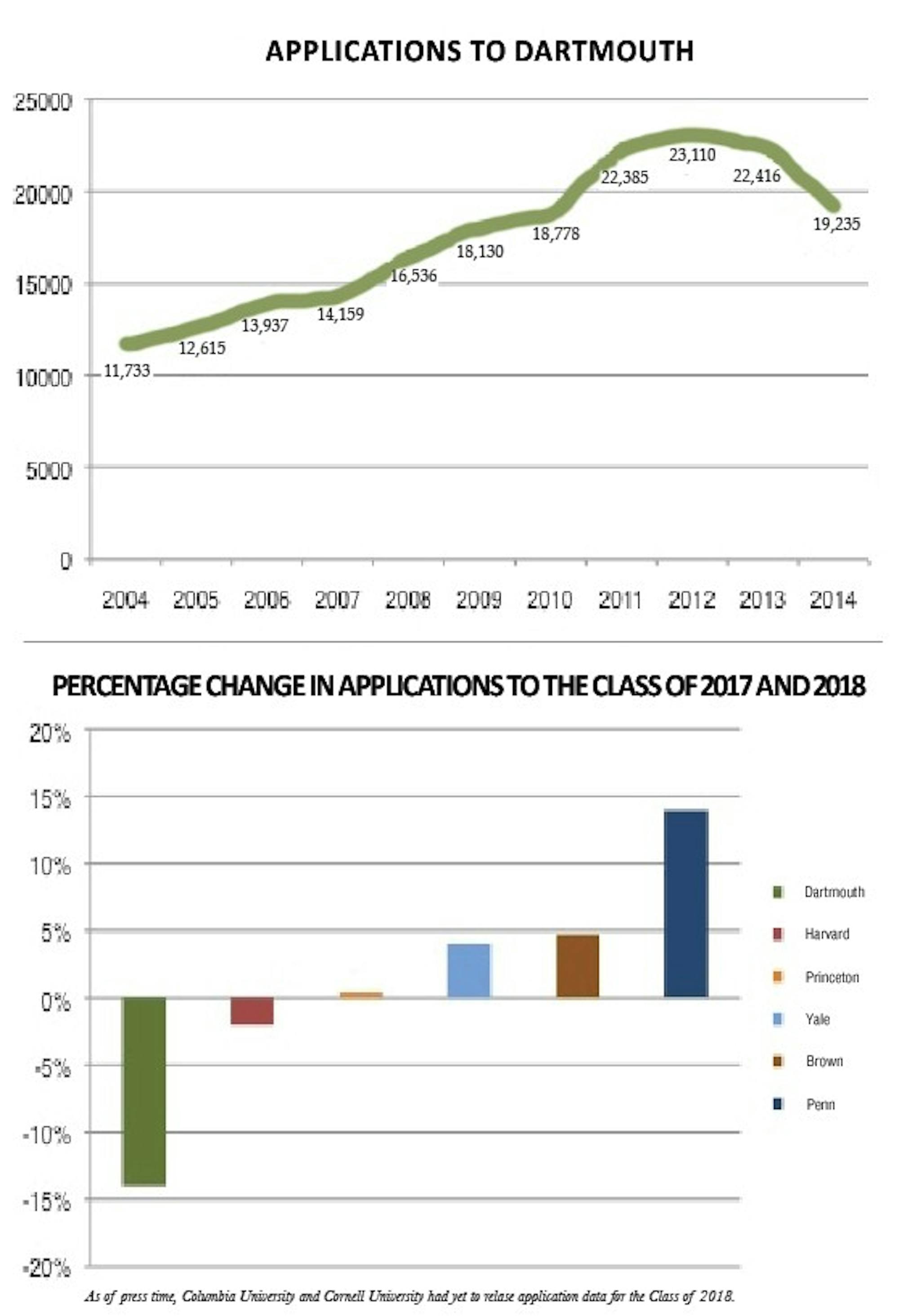The College received 14 percent fewer applications for the Class of 2018 than it did for the Class of 2017.
This year saw a total of 19,235 applicants for the Class of 2018, compared to last year’s 22,416 applicants. The College will conduct a survey of non-applicants who expressed interest in Dartmouth to better understand the shift, including students who visited campus, those who sent in test scores and those who added Dartmouth to their “My Colleges” list on the Common Application but did not ultimately apply, dean of admissions and financial aid Maria Laskaris said. The College hired communications agency Brodeur Partners to develop the survey, which it will send out this week.
The College received 20 percent fewer applications from students living abroad, 15 percent fewer from students in the Northeast and 20 percent fewer from the Midwest.
Laskaris said that the decline might be linked to nationwide demographic shifts that have resulted in more people moving to the South and West. While admissions officers at the College knew about these shifts, the drop in the number of applicants still came as a surprise after seeing a rise in the number of early decision applicants.
“We were aware that this bubble wouldn’t last forever,” she said. “But I didn’t expect that we would drop this much overall.”
Miguel Gestat, a senior at Rancho Dominguez Preparatory School in Long Beach, Calif., said that he ultimately decided not to apply to the College even though he liked its values and several of his cousins had applied in the past.
“Since I’m on the West Coast, I thought it would be inconvenient and too big of a change freshman year to move to the East,” he said.
Gestat applied to schools in the University of California system and said he plans to consider Ivy League universities when he applies to graduate school.
Laskaris said that she does not think technical issues with the new version of the Common Application hindered students from applying, as the College extended the regular decision deadline to Jan. 10 in order to accommodate the glitches.
After the Common Application launched a new online portal last August, technical problems caused some schools to extend the Nov. 1 early decision deadline. The College extended its deadline to Nov. 8, and received 1,678 applications. The College admitted 469 students to the Class of 2018 through the early decision process.
In addition to the survey, admissions officers will also speak to both alumni volunteers who interview prospective students in metropolitan areas and secondary school counselors from schools that have historically sent a large number of applications to the College.
The results of the survey and interviews will ultimately inform the way in which the admissions office addresses the drop, Laskaris said.
“We will hold off from any decisions until we have data in hand,” she said.
This year the University of Pennsylvania received a record 35,788 applicants, a 14 percent increase from last year. Brown University received approximately 30,320, marking the second-largest applicant pool in its history, while Yale University received 30,922 applicants. The figures is approximately 4 percent higher than last year, a record-high and the first time the number of applicants to the university has surpassed 30,000.
Harvard University received 34,295 applicants, a 2 percent decrease from last year, and Princeton University received a total of 26,607 applications for the Class of 2018, marking an approximately 0.4 percent increase in total applicants.
As of press time, Columbia University and Cornell University had yet to release their regular decision application numbers.
Several students expressed disappointment about the 14 percent decrease. Sarah Colon ’17 said the College’s reputation for undergraduate teaching made the news particularly surprising.
“A decrease of that significance almost feels like a personal attack on the school we all know and love,” Drew Field ’17 said.
Matthew Mirliani ’16 speculated that prospective students may have decided not to apply due to the media attention to problems on campus.
Other students emphasized that the cause of the decrease is unknown.
“I hope it doesn’t reflect a trend in public opinion regarding the school, but honestly it’s probably due to various factors that are not worth reading too much into,” Isaac Green ’17 said.
Laskaris said that the admissions office has already begun to consider how they will alter Dimensions, a weekend in April for accepted students.
This year, the College will add two additional day-long visiting programs in April during which students will attend classes, programming events and stay with a daytime host. During last year’s Dimensions program, which was at full capacity, the College could barely accommodate the number of students who wanted to attend, Laskaris said.
Students of color comprise 37 percent of applicants, the highest percentage of any applicant pool, according to a fact sheet released by the College. Approximately 70 percent of applicants applied for financial aid, marking a 5 percent increase from previous years. Laskaris said she expects that approximately 11 percent of students will be offered admission to the Class of 2018, compared to 10.4 percent last year.
“I don’t think the numbers fundamentally change what Dartmouth is and what Dartmouth offers its students,” Laskaris said. “We are still going to be highly selective.”
Sara McGahan, Jordan Einhorn and Victoria Nelson contributed reporting.




